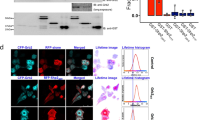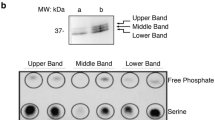Abstract
THE critical pathways through which protein-tyrosine kinases induce cellular proliferation and malignant transformation are not well defined. As microinjection of antibodies against p21ras can block the biological effects of both normal and oncogenic tyrosine kinases, it is likely that they require functional p21ras to transmit their mitogenic signals1,2. No biochemical link has been established, however, between tyrosine kinases and p21ras. We have identified a non-catalytic domain of cytoplasmic tyrosine kinases, SH2, that regulates the activity and specificity of the kinase domain3–9. The presence of two adjacent SH2 domains in the p21ras GTPase-activating protein (GAP)6,10,11indicates that GAP might interact directly with tyrosine kinases. Here we show that GAP, and two co-precipitating proteins of relative molecular masses 62,000 and 190,000 (p62 and p190) are phosphorylated on tyrosine in cells that have been transformed by cytoplasmic and receptor-like tyrosine kinases. The phosphorylation of these polypeptides correlates with transformation in cells expressing inducible forms of thev-src or v-fps encoded tyrosine kinases. Furthermore, GAP, p62 and p190 are also rapidly phosphorylated on tyrosine in fibroblasts stimulated with epidermal growth factor. Our results suggest a mechanism by which tyrosine kinases might modify p21ras function, and implicate GAP and its associated proteins as targets of both oncoproteins and normal growth factor receptors with tyrosine kinase activity. These data support the idea4–6 that SH2 sequences direct the interactions of cytoplasmic proteins involved in signal transduction.
This is a preview of subscription content, access via your institution
Access options
Subscribe to this journal
Receive 51 print issues and online access
$199.00 per year
only $3.90 per issue
Buy this article
- Purchase on Springer Link
- Instant access to full article PDF
Prices may be subject to local taxes which are calculated during checkout
Similar content being viewed by others
References
Mulcahy, L. S., Smith, M. R. & Stacey, D. W. Nature 313, 241–243 (1985).
Smith, M. R., DeGudicibus, S. J. & Stacey, D. W. Nature 320, 540–543 (1986).
Sadowski, I., Stone, J. C. & Pawson, T. Molec. cell. Biol. 6, 4396–4408 (1986).
DeClue, J. E., Sadowski, I., Martin, G. S. & Pawson, T. Proc. natn. Acad. Sci. U.S.A. 84, 9064–9068 (1987).
Pawson, T. Oncogene 3, 491–495 (1988).
Koch, C. A., Moran, M., Sadowski, I. & Pawson, T. Molec. cell. Biol. 10, 4131–4140 (1989).
Raymond, V. W. & Parsons, J. T. Virology 160, 400–410 (1987).
Wang, H.-C. R. & Parsons, J. T. J. Virol. 63, 291–302 (1989).
Verderame, M. F., Kaplan, J. M. & Varmus, H. E. J. Virol. 63, 338–348 (1989).
Vogel, V. S. et al. Nature 335, 90–93 (1988).
Trahey, M. et al. Science 242, 1697–1700 (1988).
Sherr, C. J. et al. Cell 41, 665–676 (1985).
Trahey, M. & McCormick, F. Science 238, 542–545 (1987).
De Gunzburg, J. D., Riehl, R. & Weinberg, R. A. Proc. natn. Acad. Sci. U.S.A. 86, 4007–4011 (1989).
Stahl, M. L., Ferenz, C. R., Kelleher, K. L., Kriz, R. W. & Knopf, J. Nature 332, 269–272 (1988).
Mayer, B. J., Hamaguchi, M. & Hanafusa, H. Nature 332, 272–275 (1988).
Wahl, M. L., Nishibe, S., Suh, P.-G. & Carpenter, G. Proc. natn. Acad. Sci. U.S.A. 86, 1568–1572 (1989).
Margolis, B. et al. Cell 57, 1101–1107 (1989).
Meisenhelder, J., Suh, P.-G., Rhee, S. G. & Hunter, T. Cell 57, 1109–1122 (1989).
Sadowski, I. & Pawson, T. Oncogene 1, 181–191 (1987).
Kamps, M. P. & Sefton, B. M. Oncogene 2, 305–315 (1988).
Letwin, K., Yee, S.-P. & Pawson, T. Oncogene 3, 621–627 (1988).
Kamps, M. P. & Sefton, B. M. Analyt. Biochem. 176, 22–27 (1989).
Cooper, J. A., Sefton, B. M. & Hunter, T. Meth. Enzym. 99, 387–402 (1983).
Johnson, R. M., Wasilenko, W. J., Mattingly, R. R., Weber, M. J. & Garrison, J. C. Science 246, 121–124 (1989).
Author information
Authors and Affiliations
Rights and permissions
About this article
Cite this article
Ellis, C., Moran, M., McCormick, F. et al. Phosphorylation of GAP and GAP-associated proteins by transforming and mitogenic tyrosine kinases. Nature 343, 377–381 (1990). https://doi.org/10.1038/343377a0
Received:
Accepted:
Issue Date:
DOI: https://doi.org/10.1038/343377a0
This article is cited by
-
Proteomic Analysis Reveals Differential Protein Expression Induced by Inhibition of Prolyl Oligopeptidase in Filarial Parasites
The Protein Journal (2022)
-
p190A RhoGAP induces CDH1 expression and cooperates with E-cadherin to activate LATS kinases and suppress tumor cell growth
Oncogene (2020)
-
Identification of ALV-J associated acutely transforming virus Fu-J carrying complete v-fps oncogene
Virus Genes (2016)
-
GRIM-19 inhibits v-Src-induced cell motility by interfering with cytoskeletal restructuring
Oncogene (2009)
-
p190RhoGAP-A
AfCS-Nature Molecule Pages (2009)
Comments
By submitting a comment you agree to abide by our Terms and Community Guidelines. If you find something abusive or that does not comply with our terms or guidelines please flag it as inappropriate.



